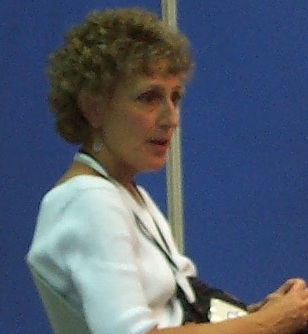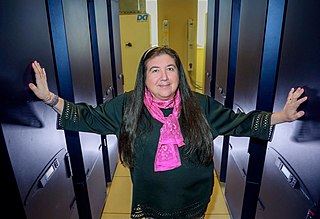Related Research Articles
GRASS is a programming language created to script 2D vector graphics animations. GRASS was similar to BASIC in syntax, but added numerous instructions for specifying 2D object animation, including scaling, translation and rotation over time. These functions were directly supported by the Vector General 3D graphics terminal GRASS was written for. It quickly became a hit with the artistic community who were experimenting with the new medium of computer graphics, and is most famous for its use by Larry Cuba to create the original "attacking the Death Star will not be easy" animation in Star Wars (1977).

Scientific visualization is an interdisciplinary branch of science concerned with the visualization of scientific phenomena. It is also considered a subset of computer graphics, a branch of computer science. The purpose of scientific visualization is to graphically illustrate scientific data to enable scientists to understand, illustrate, and glean insight from their data. Research into how people read and misread various types of visualizations is helping to determine what types and features of visualizations are most understandable and effective in conveying information.

Visualization or visualisation is any technique for creating images, diagrams, or animations to communicate a message. Visualization through visual imagery has been an effective way to communicate both abstract and concrete ideas since the dawn of humanity. from history include cave paintings, Egyptian hieroglyphs, Greek geometry, and Leonardo da Vinci's revolutionary methods of technical drawing for engineering and scientific purposes.

A cave automatic virtual environment is an immersive virtual reality environment where projectors are directed to between three and six of the walls of a room-sized cube. The name is also a reference to the allegory of the Cave in Plato's Republic in which a philosopher contemplates perception, reality, and illusion.

Daniel J. Sandin is an American video and computer graphics artist, designer and researcher. He is a Professor Emeritus of the School of Art & Design at University of Illinois at Chicago, and co-director of the Electronic Visualization Laboratory (EVL) at the University of Illinois at Chicago. He is an internationally recognized pioneer in computer graphics, electronic art and visualization.
The Electronic Visualization Laboratory (EVL) is an interdisciplinary research lab and graduate studies program at the University of Illinois at Chicago, bringing together faculty, students and staff primarily from the Art and Computer Science departments of UIC. The primary areas of research are in computer graphics, visualization, virtual and augmented reality, advanced networking, and media art. Graduates of EVL either earn a Masters or Doctoral degree in Computer Science.

Patrick M. Hanrahan is an American computer graphics researcher, the Canon USA Professor of Computer Science and Electrical Engineering in the Computer Graphics Laboratory at Stanford University. His research focuses on rendering algorithms, graphics processing units, as well as scientific illustration and visualization. He has received numerous awards, including the 2019 Turing Award.
A projection augmented model is an element sometimes employed in virtual reality systems. It consists of a physical three-dimensional model onto which a computer image is projected to create a realistic looking object. Importantly, the physical model is the same geometric shape as the object that the PA model depicts.

Lawrence Jay Rosenblum is an American mathematician, and Program Director for Graphics and Visualization at the National Science Foundation.
Bruce Howard McCormick (1928–2007) was an American computer scientist, Emeritus Professor at the Department of Computer Science, and founding director of the Brain Networks Lab at Texas A&M University.

Maxine D. Brown is an American computer scientist and retired director of the Electronic Visualization Laboratory (EVL) at the University of Illinois at Chicago (UIC). Along with Tom DeFanti and Bruce McCormick, she co-edited the 1987 NSF report, Visualization in Scientific Computing, which defined the field of scientific visualization.
Jarke J. (Jack) van Wijk is a Dutch computer scientist, a professor in the Department of Mathematics and Computer Science at the Eindhoven University of Technology, and an expert in information visualization.
Maureen C. Stone is an American computer scientist, specializing in color modeling.

Jean-Daniel Fekete is a French computer scientist.

Nadia Magnenat Thalmann is a computer graphics scientist and robotician and is the founder and head of MIRALab at the University of Geneva. She has chaired the Institute for Media Innovation at Nanyang Technological University (NTU), Singapore from 2009 to 2021.

Carolina Cruz-Neira is a Spanish-Venezuelan-American computer engineer, researcher, designer, educator, and a pioneer of virtual reality (VR). She is known for inventing the cave automatic virtual environment (CAVE). She previously worked at Iowa State University (ISU), University of Louisiana at Lafayette, University of Arkansas at Little Rock, and she is currently an Agere Chair Professor at University of Central Florida (UCF).
Holly Rushmeier is an American computer scientist and is the John C. Malone Professor of Computer Science at Yale University. She is known for her contributions to the field of computer graphics.
Jane Veeder is an American digital artist, filmmaker and educator. She is a professor at San Francisco State University in the Department of Design and Industry, at which she held the position of chair between 2012 and 2015. Veeder is best known for her pioneering work in early computer graphics, however she has also worked extensively with traditional art forms such as painting, ceramics, theatre, and photography.
IEEE Transactions on Visualization and Computer Graphics is a peer-reviewed scientific journal published by the IEEE Computer Society. It covers subjects related to computer graphics and visualization techniques, systems, software, hardware, and user interface issues. TVCG has been considered the top journal in the field of visualization.
Thomas K. Porter is the senior vice president of production strategy at Pixar and one of the studio's founding employees.
References
- ↑ "People > Staff and Academic Personnel > Tom DeFanti" . Retrieved 13 October 2009.
- ↑ Jones, Steve (2002). Encyclopedia of New Media: An Essential Reference to Communication and Technology. SAGE Publishing. p. 125. ISBN 978-1452265285 – via Google Books.
- 1 2 "Future of VR Conference". UCSD. 2015.
- 1 2 Magnenat-Thalmann, Nadia; Thalmann, Daniel (1985). Computer Animation: Theory and Practice . Spring-Verlag Tokyo. pp. 26–33. ISBN 978-4-431-70005-0.
- ↑ Jones, Steve (2002). Encyclopedia of New Media: An Essential Reference to Communication and Technology. SAGE Publishing. p. 398. ISBN 978-1452265285 – via Google Books.
- ↑ Masson, Terrence (1999). CG 101: A Computer Graphics Industry Reference. New Riders. pp. 410–412. ISBN 978-0-7357-0046-8.
- ↑ Sturman, D.J., Zeltzer, D. (January 1994). "A survey of glove-based input". IEEE Computer Graphics and Applications. 14 (1): 30–39. doi:10.1109/38.250916. S2CID 7119184.
{{cite journal}}: CS1 maint: multiple names: authors list (link) - ↑ Nielson, Gregory M.; Shriver, Bruce; Rosenblum, Lawrence J. (1990). Visualization in Scientific Computing. IEEE Computer Society Press. pp. 3, 19. ISBN 978-0-8186-8979-6.
- ↑ Sherman, William R.; Craig, Alan B. (2003). Understanding Virtual Reality: Interface, Application, and Design. Morgan Kaufmann. p. 14. ISBN 978-1-55860-353-0.
- ↑ "TransLight/Starlight: About" . Retrieved 13 October 2009.
- ↑ "OptIPuter" . Retrieved 13 October 2009.
- 1 2 "2000 ACM SIGGRAPH Awards". Archived from the original on 22 November 2009. Retrieved 13 October 2009.
- ↑ "Dig This! SIGGRAPH's Electronic Theater Celebrates 25 Years of Discovery by Wendy Jackson". awn.com. Retrieved 21 June 2022.
- ↑ Picard, Caroline (November 28, 2018). "'Chicago New Media 1973-1992' pays tribute to the city's contribution to video games and digital art". Chicago Reader. Retrieved September 26, 2018.
- ↑ Cates, Jon (2018). Chicago New Media, 1973-1992. Illinois, United States: University of Illinois Press. pp. 9, 21. ISBN 978-0-252-08407-2.